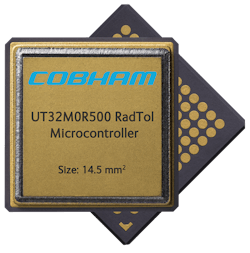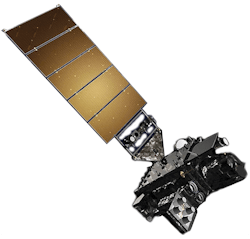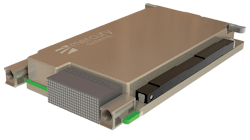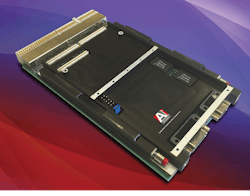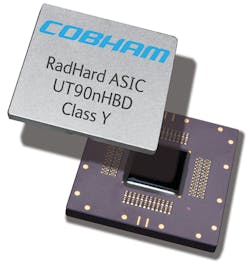The evolving world of radiation-hardened electronics
The electronics industry is developing high-reliability integrated circuits to suit a variety of space applications, and is tailoring different levels of reliability for specific missions where SWaP, cost, and performance are top considerations.
Among the most destructive forces known for deployed aerospace and defense electronics systems is radiation. This force can occur naturally in space and at high altitudes on Earth, or can come in massive doses from the detonation of nuclear weapons. Either way, it’s crucial for engineers designing for radiation environments to use radiation-hardened electronic components.
One of the biggest questions today, however, is how much radiation hardening is necessary? Money was no object decades ago when it was the norm for designers to harden military electronics to meet anticipated Cold War nuclear weapons threats. It’s different now — particularly with the boom in commercial and government satellites, as well as traditional space applications the involve long-term satellite missions in high-Earth orbits.
New generations of high-performance communications and reconnaissance orbiting satellites are using some of the most advanced radiation-hardened and radiation-tolerant integrated circuits for mission reliability.
To be sure, radiation threats to electronics from potential nuclear weapons detonations, on Earth and in space, still exist. In fact, industry experts say demand is increasing in a relatively small market niche for electronics and components able to withstand the effects of nuclear explosions.
Still, today’s biggest market driver for radiation-hardened electronics is low-Earth-orbit space applications in communications and Earth observation, where missions might last only for a few years — or even just months — and where threats from space radiation are relatively low.
Adding vastly to demand for electronics able to deal with radiation is an emerging market called “NewSpace,” which consists of small short-duration spacecraft sometimes called cubesats, as well as massive future constellations of small communications satellites intended to blanket the Earth with Internet connectivity, which will use rapidly replaceable satellites, and networks with built-in redundancy to cope with occasional spacecraft failures.
NewSpace is driving technology innovation radiation hardened electronics that strives for the smallest, most capable, and most affordable radiation-hardened technology possible that adequate to meet the needs of relatively benign radiation and short mission durations.
NewSpace rad-hard
NewSpace describes a globally emerging private spaceflight industry seeking to develop quick and affordable access to space, driven primarily by commercial considerations. It involves commercial off-the-shelf (COTS) electronic technologies, open-systems architectures, standards-driven approaches, and design approaches that once would be considered unthinkable for space. In short, NewSpace is the domain of “good enough” for the target environment to make the most of performance, affordability, and size, weight, and power consumption (SWaP).
“Many kinds of satellite operators are trying to deploy more quickly and cheaply, and are looking at components of lower screening levels than traditional QML [Qualified Manufacturing List],” explains Ken O’Neill, director of marketing for space and aviation at Microsemi Corp. in Aliso Viejo, Calif.
This involves anything “from pure plastic-packaged COTS parts, all the way to screening just below QML, or ‘sub-QML’,” O’Neill says. “We are exploring ways of offering radiation-tolerant parts with less screening than a traditional QML flow to save lead time and component costs.”
Microsemi integrates the company’s radiation-tolerant RTG4 field-programmable gate array on a variety of embedded computing boards for on-orbit space uses.
This approach has the potential for dramatic reductions in space electronic components, which is significant in a market where low-Earth-orbit satellites typically cost several thousand dollars per pound to launch. “You can cut the price of a computer board in half,” says Doug Patterson, vice president of the military and aerospace business sector at Aitech Defense Systems Inc. in Chatsworth, Calif.
Reducing costs, however, requires a compromise in quality, radiation hardness, reliability, or mission duration. It all depends on the mission and if these kinds of compromises are worth it. “There is a slight relaxation from the space community, compared to traditional manned and unmanned vehicles, of the components with strict conformance to NASA specs,” Patterson says. “Our customers are allowing us to buy the parts with some traceability, but in plastic parts instead of ceramic parts, and with a minimum lot size. This has allowed us to use mil-grade or automotive-grade parts that we upscreen, and it has had a huge impact on the price of the space market.”
Several factors are at work that make compromised reliability pay off in the long run; it all boils down to the target mission, its expected operating environment, and the projected risks. NASA, for example, is asking for satellite constellations in which failed satellites can hand off functionality to nearby satellites, and then automatically deorbit themselves to cut down on space junk and reduce program risks. “Rad-hard scares people in the NewSpace market,” Aitech’s Patterson says. “The prices are way too high; single parts can cost $40,000 or $50,000.
Cost sensitivities
Some companies are finding themselves in the NewSpace market almost by surprise. “Periodically we get a customer who needs a rad-tolerant data drive [SSD],” says Bob Lazaravich, director of secure storage at the Mercury Systems Advanced Microelectronics Solutions group in Phoenix. “Out terrestrial solid-state drive expertise is what we are bringing to the rad-hard world.”
Sometime last year, Mercury officials found a customer asking for a rad-tolerant SSD. “The timing was perfect,” Lazaravich says. “Demand has amazed us. There is more interest in this than we have had in our secure SSDs previously. We have a first-generation device, and are working on a second-generation device.” On hindsight, strong demand shouldn’t have been such a surprise. “If you’re in space, you’re collecting imaging or sensor data, and you need storage for that,” he says. “It’s a perfect match for us to build a rad-hard SSD.”
Cobham is offering the RadTolerant Arm Cortex -M0+ microcontroller for space applications with an integrated analog front end and on-board volatile and non-volatile memory.
Mercury starts with commercial-grade Flash memory, and upscreen the parts to withstand the effects of 100 kilorads of total-dose radiation. The company also uses the RTG4 field-programmable gate array from Microsemi. “There is screening that goes on for each device that goes into the product,” says Mercury’s Lazaravich. “They are all SLC devices with as large of geometries as we can find — the older ones. We have them tested for different kinds of radiation effects, and then we build-in radiation mitigations to account for the kinds of failures we might expect.”
Just as Mercury experts were surprised to find themselves in the NewSpace market, they also might be surprised to find themselves part of the traditional space market. The company’s first-generation 440-gigabyte space SSD should be able to hold up for a three-year mission in space, but the second-generation 1-terabyte device might be able to operate in space for 10 years or longer, Lazaravich says.
“For the first generation we kept everything simple,” Lazaravich says. “We used no microprocessors, and used a whole new design approach to building a drive. The second generation looks more like our normal hard drive, and in the future third generation we expect to be indistinguishable from a SSD you build buy in the store — but far more reliable.”
So what’s the secret to screening parts to be just good enough for space applications? “You model the orbit, and use collected radiation data from space,” explains Mark Tiddens, product sales manager at Data Device Corp. (DDC) in Poway, Calif. “You look at the thickness of the spacecraft shell, the electronics box aluminum, and at what is the rad-tolerance of the die to determine how thick the shielding needs to be.”
DDC specializes in radiation-shielded packaging the company calls RAD PAK, which takes a commercial die with a 5-to-10-kilorad total-dose tolerance, and add enough shielding to take that part to 100 kilorads or more. “You can prescribe the necessary shielding based on the specific target orbits,” Tiddens says. “We have parts that are rad-tolerant enough, or we can add our RAD PAK shielding for even more hardness.”
It all comes down to where the spacecraft must operate. “NewSpace looks at old space as being over-designed and over-tested,” Tiddens says. The movement is towards optimizing the radiation tolerance and cost to a specific mission,” he continues. “If it’s in low-Earth orbit for 10 years, you have to worry about 50 kilorads, but if it’s five years it could be down to 40 kilorads for these parts.”
When it comes to NewSpace design approaches, however, it’s difficult to avoid program risk, experts admit. “This is an exciting and disruptive movement,” says Tiddens. “Nobody really knows why these parts fail in space. You can do the modeling and say this is the radiation requirement, but some NewSpace people are just doing trial and error. Some parts work fine, but some don’t; it’s a tough situation to optimize.”
Test and qualification
It’s easy to talk about radiation testing and qualification to upscreen commercially available parts for use in space, but quite another actually to carry out these procedures. It takes expertise, time, and specialized test and measurement equipment to come up with accurate characterizations of how commercial parts will behave in space.
“In the NewSpace market now, small satellite startups are not looking to implement rad-hard components, but to get any data they can to see if commercial parts are rad-tolerant,” says Aridio Sanchez, executive director of rad-hard test and measurement specialist VPT Rad Inc. in Chelmsford, Mass. “We do radiation-effects testing to qualify the devices, and to see if they are rad-hard or rad-tolerant. Typically, parts that are screened to be much lower than rad-hard are more cost-effective.”
It’s up to VPT Rad, and test houses like it, to document if commercial-grade parts can stand-up to the space radiation environment. “We have a suite of test equipment that can support technologies from discretes up to complicated memory products,” Sanchez says. “Customers drop off their parts, and we take care of everything else. A company may have a project where they want us to qualify parts to be radiation-hardened, and we have to prove that.”
The space electronics market is hot, as VPT Rad’s business would attest. “NewSpace is pretty heavy, and the market is getting very competitive with a lot of folks trying to get into the same market,” Sanchez says. “That is pretty much the major switch in the business we have been seeing over the past 10 years in radiation testing.”
The TRRUST-Stor secure solid-state drive (SSD) for trusted computing applications comes in a radiation-hardened version for orbiting satellites and manned space missions.
Sanchez says the majority of his customers are from the commercial world who are trying to get into the space market and find more cost-effective ways to get rad-tolerant parts into their systems. The company also serves government customers who are trying to characterize just the right parts for long-term programs.
Traditional space electronics
Several companies specializing in radiation-hardened electronics have been in business for years, if not decades, and were veterans of the market long before NewSpace ever got its name. Microsemi’s O’Neill describes traditional space as high-end systems for national defense, long-term NASA space missions, and high-revenue telecommunications “where there is lots of money or very high states resting on those systems.”
The Microsemi RTG4 rad-hard FPGA is going aboard a wide variety of orbiting satellites that must operate in radiation environments.
Microsemi provides the LX7720 rad-tolerant position sensing and motor controller and LX7730 telemetry controller. The 7730 is qualified to MIL-PRF-38535 QML Class Q and Class V — the government’s highest quality standards for space — and the 7720 is on a path to QML qualification, O’Neill says.
Microsemi also provides the RTG4 radiation-tolerant field-programmable gate array (FPGA) that has been qualified to QML Class Q, and is on a path to QML Class V sometime this summer.
VPT Inc. in Blacksburg, Va., for example, specializes in rad-hard power electronics like DC-DC converters. “We are spending a lot of effort on point-of-load converters, which needs to support high-performance digital electronics for space, like single-board converters, FPGAs, and peripherals,” says Brandon Witcher, senior design engineer at VPT Inc.
One issue driving VPT’s designs is the need to develop power electronics for a wide range of input voltages — some even for 12-volt input voltages. “Once a lot of digital electronics was using a 5-volt distribution bus, but then as voltages continue to shrink, a lot of that went to 3.3 volts. The 3.3-volt device can directly power I/O and peripherals, and can use the point-of-load converter to power-down to a lower voltage.”
At higher voltages, the current starts to increase, and puts a lot more current through the distribution bus, Witcher says. “If you can increase the distribution bus, you can increase the voltage and lose less power along the line. Some people are distributing at 5 volts, some at 3.3 volts, and some at 12, and we want to hit all those targets.”
For traditional and NewSpace electronics applications, one thing is clear: the increasing need for ever-smaller and more power-efficient electronics. “Small size is extremely important, so we try to shrink the size as much as we physically can,” Witcher says. “The need for lower voltage and higher current on spacecraft is driving us to a trend in higher-voltage input buses.”
Cobham Semiconductor Solutions in Colorado Springs, Colo., has been involved in the space electronics market for at least three decades. A veteran of the traditional space market, Cobham officials are capitalizing on their experience to expand into the NewSpace market.
The Aitech SP0-S 3U CompactPCI radiation-tolerant single-board computer based on the PowerPC microprocessor, is for NewSpace applications for deployment in low-Earth orbit.
QML standards
One of Cobham’s recent achievements is helping the U.S. Defense Logistics Agency define the new Class Y requirements for non-hermetic rad-hard space parts, according to MIL-PRF-38535 — the U.S. military specification that establishes performance and verification requirements of single-die integrated circuit devices.
“We were the first company awarded a Class Y certification in 2014,” says Michelle Mundie, business area director for standard products at Cobham. “We offer a qualified ceramic flip-chip column grid array package, which reduces overall size, footprint, and costs for rad-hard performance, while enhancing performance.”
BAE Systems uses radiation-hardening by design to produce the RAD 5545 system-on-chip rad-hard microprocessor, which company officials say is one of the most reliable radiation-hardened processors available.
Cobham also is adapting a volatile- and non-volatile memory in a ceramic hermetic package to an organic non-hermetic package that meets Class Y guidelines. “We are working with DLA on implementing to standards around organic packaging, which we are hoping to be in 2019,” Mundie says.
Traditionally, Cobham has provided rad-hard electronics parts for national security programs like geosynchronous military satellites, navigation satellites, tracking and data satellites, as well as weather satellites. The company has long-term expertise in rad-hard computing and processing; imaging, sensing, and distributed command and control; telemetry; RF phased arrays; and distributed power architectures.
From there, Cobham experts are evolving their designs toward integrated and differentiated system-on-chip solutions that are reliable and affordable enough even for NewSpace applications. “Addressing SWaP-C also drives down our costs to make our products more affordable,” Mundie says.
The company is developing a radiation-tolerant, 32-bit ARM Cortex-M0 processor plus microcontroller, which took a discrete solution and integrated its design onto a one-chip solution. “We integrated a complete front-end analog signal chain, which includes a 12-bit ADC [analog-to-digital converter] with a programmable gain amplifier, 16-channel multiplexer, two 12-bit DACs [digital-to-analog converters], and comparators and timers,” Mundie says.
For the future, Cobham officials are focusing on their company’s core military, commercial, and civil space markets and are expanding into NewSpace applications in small satellites, mega-constellations, as well as sensing, imaging, and energy harvesting for spacecraft on-board power.
“These new markets do have a different structure, so they are not 15-to-20-year missions,” Mundie says. “They are 2-to-5-year missions, with some level of radiation hardening. That also is putting pressure on Cobham to reduce flows and become more innovative.” Meeting those requirements involves developing subsets of traditional space requirements to provide systems designers with the size, performance, and costs they want.
Cobham helped craft the government’s Class-Y radiation-hardened standards to accommodate non-hermetic electronic parts for use in space.
“Our customers say we need cheaper products, so how do we perform a subset of the qualification requirements that will meet their needs,” Mundie says. “It provides a lower level of reliability and some radiation assurance, and is looking for the ‘good-enough’ solution for the LEO orbit that is going up there for two to five years.”
Rad-hard by design
Although demand is relatively light, applications still exist for the most radiation-hardened electronics parts, despite their high costs, lag in technology, and long wait times. Among the providers of these parts, which are designed from the ground-up to be radiation hardened are the BAE Systems Electronic Systems segment in Manassas, Va., and the Honeywell Inc. Radiation Effects Center of Excellence in Clearwater, Fla.
“The government still needs systems that are hardened for weapons effects, such as the SBIRS [Space-Based Infrared Surveillance] system to monitor for weapons launches,” says Paris Wiley, senior technical manager at Honeywell. The upcoming global positioning system (GPS) program to update the nation’s navigation satellites also will electronic components able to survive and operate through nuclear events.
Honeywell operates an integrated circuit fab in Plymouth, Minn., that produces electronic parts designed especially for radiation hardness. Among the military systems that require radiation hardness of this magnitude also are the next-generation land-based intercontinental ballistic missile (ICBM) — also known as the Ground-Based Strategic Deterrent (GBSD), Trident submarine-launched ballistic missile, and upgrades to the Minuteman ICBM. “There has been a lot of recent activity in modernizing our strategic missiles,” Wiley points out.
“For these applications, the requirements haven’t been relaxed; for our strategic capabilities, they have remained roughly the same,” Wiley says. “That’s where the Plymouth foundry comes in, and why it is such a critical national asset.”
In the future, it’s likely that rad-hard chip designers will combine techniques in rad-hard by design with radiation-mitigation techniques to ensure the highest possible reliability, yet provide strategic weapons systems designers with the latest electronic technologies. “For strategic applications, we could combine a rad-hard-by-design part where we can get them, with radiation mitigation with analog and digital filtering, shielding, and running computations at different times and comparing them to enable the system to respond to potential corruption,” Wiley says.
Still, there remains a need for rad-hard by design to the highest standards, even though the market for these parts is shrinking. “The foundry is a national asset,” Wiley says. “It is the only place that makes digital parts like processors and memories that can tolerate radiation to these levels.”
Weapons-grade rad-hard
Recent global tensions illustrate the need to maintain this kind of rad-hard capability. “One of the biggest challenges we have seen is that space is no longer a sanctuary,” says Ricardo Gonzalez, product line director for space systems at the BAE Systems Electronic Systems sector in Manassas, Va. “We must be able to deploy space systems and have the ability to defend them, and DOD [the U.S. Department of Defense] is putting in significant funding for that.”
At BAE Systems, pure rad-hard by design work has gone away over the past 10 years, but the company still is in the business of providing the most advanced rad-hard processors and general-purpose computers for government space and military programs.
“Rad-hard by design is no longer necessary,” Gonzales says. “We can leverage commercial foundries to have the wafers fabbed, and bring the wafers back into BAE Systems in Manassas. We operate fabless, but all our rad-hard capabilities are still here.”
BAE Systems provides the RH45 45-nanometer semiconductor technology that enable the next generation of rad-hard electronic parts that make the most of SWaP. Using this we can build anything from ASICs [application-specific integrated circuits], to a next-generation processor on a chip,” Gonzalez says. He calls the BAE Systems RAD 5545 system on chip, which uses RH45 technology, “the most advanced microprocessor available for space today.”
It’s a rad-hard quad-core processor that delivers 5.6 billion instructions per second, and can withstand radiation levels to 1 megarad of total-dose radiation. The RAD 5545 is the basis of a radiation-hardened single-board computer that meets open-systems VPX standards, that will go into several national defense systems.
The SCS750 radiation-hardened single-board computer from Data Device Corp. is for mid- and high-performance space embedded computing, and on-board data processing on the spacecraft.
Looking to the future, Gonzalez says it’s no longer adequate to build rad-hard electronics that can survive tremendous levels of radiation. Today it’s necessary to design rad-hard electronics with the ability to support fast-changing threats from U.S. adversaries.
“Smaller platforms will be in high demand, and reprogrammability is a necessity. Higher levels of integration afford bigger missions with smaller footprints,” Gonzalez says. Future rad-hard electronics also must be able to support cyber resiliency, autonomous operation, and other advanced capabilities.
Toward this goal, BAE Systems experts are working on future technology nodes able to yield 28-, 22-, 14-, and sub-10-nanometer chip technologies. “This aggressive reduction in size, weight, and power will afford much smaller systems that can handle more threats autonomously and drive more missions for the hardware on orbit,” Gonzalez says.
COMPANY LIST
Aitech
Chatsworth, Calif.
http://www.rugged.com
BAE Systems
Manassas, Va.
https://www.baesystems.com/en-us/our-company/inc-businesses/electronic-systems/product-sites/space-products-and-processing
Cobham Semiconductor Solutions
Colorado Springs, Colo.
https://ams.aeroflex.com/aboutus/au-cos.cfm
Data Device Corp. (DDC)
Bohemia, N.Y.
http://www.ddc-web.com
Honeywell Aerospace
Clearwater, Fla.
https://aerospace.honeywell.com/en/markets/space
Infineon Technologies
El Segundo, Calif.
https://www.infineon.com
Intersil
Milpitas, Calif
https://www.intersil.com/en.html
Maxwell Technologies
San Diego
http://www.maxwell.com
Mercury Systems
Andover, Mass.
https://www.mrcy.com
Microelectronics Research Development Corp.
Colorado Springs, Colo.
http://www.micro-rdc.com/index.htm
Micropac Industries Inc.
Garland, Texas
http://www.micropac.com/MII-Home.html
Microsemi
Aliso Viejo, Calif
https://www.microsemi.com
Northrop Grumman Corp.
Manhattan Beach, Calif.
http://www.northropgrumman.com/Pages/default.aspx
pSemi Corp.
San Diego
http://www.psemi.com
Space Micro
San Diego
http://www.spacemicro.com/index.html
Triad Semiconductor Inc.
Winston-Salem, N.C.
https://www.triadsemi.com
VPT Inc.
Blacksburg, Va.
http://www.vptpower.com
VPT Rad
Chelmsford, Mass.
http://www.vptrad.com



